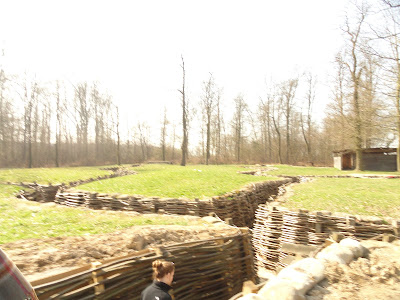


Menin Gate is one of the larges attractions of Ieper. It's a World War I memorial for the British. Now, almost every surface of this building is covered in names in tiny font, organized by country and station. When I say British, this includes the British Empire, so this memorial includes men from India, Australia, South Africa, Ireland, and volunteers from Canada. The Canadians were afraid if the British lost, us Americans would swallow them up without their defense haha. But in all seriousness, there are thousands of names of the dead from the First World War and this is only one of the many memorials. Even today, they excavate fields and find more bodies, and more names and add to the memorial. They literally don't have enough room on this huge structure to include all the dead.
Every evening, they have a ten minute ceremony at 8:00 pm. Everyone gathers as a couple of volunteers play trumpets and children from local schools place Poppie reefs of remembrance on a stand. During the 10 minutes, no one speaks and everything is still. Even to this day, it is a very emotional event, even for the locals, and it happens every single day. WWI is remembered clearly even to this day.
History behind the Poppies: In Britain, instead of Yellow Ribbons like us Americans do to remember fallow soldiers, they lay down plastic Poppie flowers. This started after the First World war. The fields on which the trenches were dug and the battle was fought were poppy fields. The bombs would ravish the fields and would disturb the poppy seeds, which would stain the mud blood red. The fields turned red with real blood and the stain of the poppy seeds. It was a terrifying sight for the soldiers, and extremely symbolic to what was going on at the time. I can't even begin to imagine how revolting it would look. So today, it is a symbol of the pain and suffering that was endured during WWI.



 So the English did something quite horrid in Langemarck. ROTCs from Berlin University (students exactly my age) were sent by their officer toward British troops. They were outnumbered and inexperienced. The British rounded them up, and shot them all. The first two pictures are from the memorial to them, and I even found a Bayer, Leonard. The rest of the cemetery is dedicated to other German casualties, where I found 13 Bayers, my father's mother's maiden name. When I get back to the states I want to look them up to see if there's any relation: Adolf Bayer, Andreas Bayer, Anton Bayer, Emil Bayer, Ernst Bayer, Friedrich Bayer, George Bayer, Heinrich Bayer, Heinrich Bayer, Hermann Bayer, Jakob Bayer, Jakob Bayer, and Johann Bayer.
So the English did something quite horrid in Langemarck. ROTCs from Berlin University (students exactly my age) were sent by their officer toward British troops. They were outnumbered and inexperienced. The British rounded them up, and shot them all. The first two pictures are from the memorial to them, and I even found a Bayer, Leonard. The rest of the cemetery is dedicated to other German casualties, where I found 13 Bayers, my father's mother's maiden name. When I get back to the states I want to look them up to see if there's any relation: Adolf Bayer, Andreas Bayer, Anton Bayer, Emil Bayer, Ernst Bayer, Friedrich Bayer, George Bayer, Heinrich Bayer, Heinrich Bayer, Hermann Bayer, Jakob Bayer, Jakob Bayer, and Johann Bayer. 








































